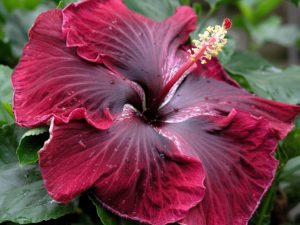HIBISCUS

HIBISCUS is known for its large bright flowers in the species commonly known as “hibiscus,” which is not known as rose mallow.
Hibiscus flowers can be found in various colors, including red, orange, yellow, pink, white, and purple. They also come in multiple shapes and sizes, with some flowers reaching up to twelve inches across. Hibiscus flowers are usually short-lived, lasting only one to three days, but they are often produced in large quantities, providing a long flowering period. Hibiscus flowers are used for a variety of purposes, including:
- Ornamental: Hibiscus flowers are ornamental plants in gardens and patios. They are also used in flower arrangements and necklaces.
- Culinary: Hibiscus flowers can be eaten fresh or cooked. They are often used in salads, soups, stews, and desserts. Hibiscus flowers can also be used to make tea, known for its mild, refreshing taste and health benefits.
- Medicine: Hibiscus has been used in traditional medicine for centuries to treat various conditions, including high blood pressure, high cholesterol, liver disease, and inflammation. Here are some health benefits of hibiscus flowers:
- Lowers Blood Pressure: Hibiscus tea has been shown to lower blood pressure in people with high blood pressure.
- Lower cholesterol: Hibiscus tea can help lower cholesterol levels. • Improve liver health: Hibiscus tea can help protect the liver from damage.
- Reduce inflammation: Hibiscus tea can help reduce inflammation in the body. • Promote weight loss: Hibiscus tea can help promote weight loss by increasing metabolism and reducing appetite.
Hibiscus is generally safe for most people, but it’s essential to know that it can interact with some medications. If you are taking medication, consult your doctor before consuming hibiscus.
WHY BUY DRIED HIBISCUS FROM COMMODITY 1
Although Nigerian dry hibiscus shares some similarities with hibiscus species from other regions, its unique flavor, cultural importance, and traditional uses make it unique and highly valued in Nigeria and elsewhere. And all over the world. If you want to try it, you can find dried Nigerian hibiscus in specialty stores or online retailers that offer international food products. Nigerian dried hibiscus, commonly known as ‘Zobo’ or ‘Sobolo,’ is known for its unique taste and quality, which makes it different from other cultivated hibiscus species.
Here are some characteristics and features of Nigerian dried hibiscus:
- Rich flavor profile: Nigerian dried hibiscus is known for its strong and sweet flavor. It has a deep purple color and a tart, sour taste, often described as a combination of cranberry, raspberry, and citrus notes. This unique flavor is sought after for use in various spices.
- Natural growing conditions: Hibiscus sabdariffa, the plant from which dry hibiscus is harvested, thrives in the tropical climate of Nigeria. A rich, fertile soil and the best climate contribute to the development of hibiscus flowers with an intense color and flavor.
- Traditional Uses: Nigerian dried hibiscus has been used for centuries in traditional food and herbal medicine. It is the main ingredient behind Zobo, a popular and refreshing drink in most Nigerian homes. It is also used for its potential health benefits, such as high levels of vitamin C and other health-promoting properties.
- Culinary Versatility: Apart from alcohol like Zobo, Nigerian dried hibiscus is used in various spices. It can be added to sauces, marinades, salads, and desserts to give the dish a unique flavor and excellent color.
- Export quality: Due to its unique taste and quality, Nigerian dried hibiscus has become a sought-after commodity in the world market. It is often exported to other countries for use in producing hibiscus teas, herbal infusions, and various food products.
- Cultural Significance: Dried hibiscus is a valuable commodity in Nigeria, often used for festivals, events, and gatherings. It symbolizes hospitality and is usually offered to guests as a refreshing drink.
PACKAGING & DELIVERY (DRIED HIBISCUS)
| Packaging Details: | Dried, Bulk | |
| Port: | Lagos Apapa Port, Nigeria | |
| Bags: | 50 kg | |
| Container: | 20 ft | |
| Lead time: | ||
| Quantity (metric tons) | 25MT/Month | 50MT/Month |
| (Lead days) | 30 Days | 30 Days |
THE LARGEST HIBISCUS-PRODUCING COUNTRIES ARE:
- China
- India
- Egypt
- Thailand
- Sudan
- Mexico
- Indonesia
- Brazil
- Nigeria
- Philippines
MARKET SIZE
The dried hibiscus market size reached US$ 120 million in 2022. The market is expected to grow at a CAGR of 6.8% during the forecast period 2023-2028 to reach 166.9 million dollars by 2028. The growth of the dried hibiscus market is driven by several factors, including:
- consumers’ awareness of the health benefits of hibiscus
- Growing demand for hibiscus-based foods and beverages
- Growing use of hibiscus in the cosmetic and medicinal industry
CHEMICAL CONSTITUENTS AND HEALTH BENEFITS
| CHEMICAL COMPOUND | POTENTIAL HEALTH BENEFITS | |
| Anthocyanins | Powerful antioxidants | may reduce inflammation and improve heart health |
| Organic acids | Digestive System | Giving hibiscus its tart flavor may also have some health benefits, such as improving digestion and boosting immunity. |
| Vitamin C | Immunity | Antioxidants and nutrients necessary for immune function |
| Minerals | Minerals | Essential minerals: Potassium, calcium, and magnesium |
| Flavonoids | Anti-inflammatory compounds | may reduce the risk of chronic diseases such as heart disease, cancer, and Alzheimer’s disease |
| Other compounds | Other compounds | Polysaccharides, tannins, and terpenoids which have a variety of potential health benefits, such as reducing inflammation, boosting immunity, and fighting cancer |

COMMODITY 1 CORPORATION
867 Boylston Street, 5 TH Floor
Boston, MA 02116 USA
For information: info@commodity1.com
For sales: sales@commodity1.com
CALL US : +1 (617) 224- 7119
COMMODITY 1 CORPORATION
